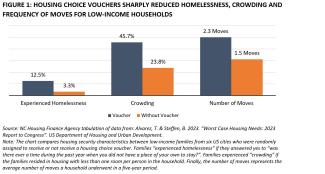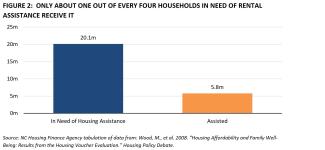
Living in safe, quality affordable housing provides the foundation to support healthy, productive lives for North Carolinians. This blog, in conjunction with North Carolina Housing Finance Agency’s recently published Benefits of Housing reports and its Program Impact reports, provides an overview of just some of the key benefits that affordable housing offers—from increased housing stability to improved health outcomes and higher lifetime earnings.
Rental assistance, a form of financial assistance that helps pay all or some of a household’s rent and is typically funded by governmental entities or nonprofits, uses existing housing stock and right-sizes the rent for a household. The NC Housing Finance Agency, in partnership with the North Carolina Department of Health and Human Services, administers rental assistance that is dedicated to ensuring benefits of affordable housing are made available to households who often have difficulty finding affordable, quality housing.
For example, the Transitions to Community Living Voucher (TCLV) helps income-eligible people with certain disabilities move from institutional settings into integrated community settings. In addition to TCLV, the Agency offers Key Rental Assistance which helps make apartments affordable to income-eligible people who are disabled or are experiencing homelessness and can help pay for security deposits and certain other costs. In 2024 alone, the Agency assisted 3,150 households with TCLV and another 2,430 households with Key Rental Assistance [1].
For these families and the thousands of others who have gained access to affordable housing through these types of programs, research has repeatedly shown innumerable health, educational and economic benefits.
Rental Assistance Increases Housing Stability
Living in unaffordable housing means residents “must make difficult choices between putting food on the table, paying for medical care, affording childcare or education or making rent or mortgage payments” or residents sacrifice the quality of their housing to obtain affordability. Having quality, safe, decent affordable housing can prevent these negative outcomes and lead to greater housing stability.
Research has repeatedly shown that families receiving rental assistance experience greater housing stability than similarly situated families who do not receive assistance [2], [3]. The federal Housing Choice Voucher program allows a low-income household to receive a voucher to help pay the rent for a decent, safe and affordable rental unit. Research has found that these vouchers greatly reduced crowding, homelessness and housing instability (see Figure 1 below) [4].

Rental Assistance Benefits Childhood Outcomes
Living in affordable housing provides numerous benefits for children—from higher academic achievement and improved physical and mental health to higher lifetime earnings.
With rental assistance, researchers have found that housing stability increases overall and also leads to better outcomes for children. Compared to peers with similar backgrounds, children in households receiving rental assistance miss fewer days of school [5]. Better school attendance is associated with improved educational outcomes like higher test scores, higher graduation rates and higher college enrollment rates [6]. More, rental assistance for children has been linked to better health, increased future income and decreased future rates of incarceration [5], [7]. Research has also shown that children in households receiving rental assistance have fewer sleep disruptions, fewer behavioral problems, better social behavior, increased likelihood of college attendance and more [2], [8].
Rental Assistance Improves Health-Related Outcomes
Affordable housing in general and rental assistance specifically are linked to better health-related outcomes for both children and adult residents. These benefits come in the form of improved physical and mental health as well as less spending on health care, improved access to health care, lower uninsured rates and decreased likelihood of residents having unmet health needs due to cost [2], [9], [10]. The “Family Options Study” performed by HUD finds that rental assistance is associated with improved adult mental health and reduced psychological distress. It also found evidence that rental assistance is associated with lower rates of alcohol or drug dependency [8].
Overall, research has found that “people receiving assistance had significantly better outcomes across nearly all measures explored” [3]. Despite the depth of these benefits, many families do not receive the assistance they need. While more than 20 million cost-burdened low-income [11] households needed rental assistance in 2023, less than 6 million received it (see Figure 2 below) [12].

The NC Housing Finance Agency provides safe, quality, affordable housing to help North Carolinians achieve these benefits through its many programs that include:
- Offering low-cost mortgages and down payment assistance to home buyers
- Financing the rehabilitation and repair for current home owners to prevent displacement
- Financing the development of rental housing
- Financing the development of supportive housing for North Carolinians with special housing needs
- Providing foreclosure prevention counseling through HUD-approved housing counselors
- Administering rental assistance, including Section 8, the Transitions to Community Living Voucher and Key Rental Assistance.
Additional information about these programs and more can be found in NC Housing Finance Agency’s Affordable Housing is Our Business and on the Agency’s website, www.nchfa.com.
------------------
[1] North Carolina Housing Finance Agency. 2024. “Rental Assistance Partnerships: 2024 Impacts. Link
[2] Fischer, W., et al. 2019. “Research Shows Rental Assistance Reduces Hardship and Provides Platform to Expand Opportunity for Low-Income Families.” Link.
[3] Schapiro, R., et al. 2021. “The Effects of Rental Assistance on Housing Stability, Quality, Autonomy, and Affordability.” Housing Policy Debate. Link.
[4] Wood, M., et al. 2008. “Housing Affordability and Family Well-Being: Results from the Housing Voucher Evaluation.” Housing Policy Debate. Link.
[5] Fenelon, A., et al. 2021. “The Benefits of Rental Assistance for Children's Health and School Attendance in the United States.” Demography. Link.
[6] See, e.g., Gottfriend, M. 2011. “The Detrimental Effects of Missing School: Evidence from Urban Siblings.” American Journal of Education. Link; Liu, J., Lee, M. & Gershenson, S. 2021. “The short- and long-run impacts of secondary school absences.” Journal of Public Economics. Link.
[7] Andersson, F., et al. 2018. “Childhood Housing and Adult Earnings: A Between-siblings Analysis of Housing Vouchers and Public Housing.” NBER Working Paper Series. Link.
[8] Gubuts, D., et al. 2016. “Family Options Study: 3-Year Impacts of Housing and Services Interventions for Homeless Families.” Link.
[9] Denary, W., et al. 2021. “Does Rental Assistance Improve Mental Health? Insights from a Longitudinal Cohort Study.” Social Science and Medicine. Link.
[10] Simon, A., et al. 2017. “HUD Housing Assistance Associated With Lower Uninsurance Rates And Unmet Medical Need.” Health Affairs. Link.
[11] A household is cost burdened if it spends 30% or more of household income on housing costs. And, a household is considered low income if the household income is at or below 80% of the area median income.
[12] Alvarez, T. & Steffen, B. 2023. “Worst Case Housing Needs: 2023 Report to Congress”. US Department of Housing and Urban Development. Link.